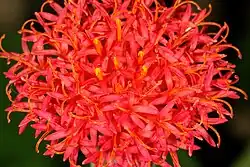Kleinia stapeliiformis
| Kleinia stapeliiformis | |
|---|---|

| |
| Scientific classification | |
| Kingdom: | Plantae |
| Clade: | Tracheophytes |
| Clade: | Angiosperms |
| Clade: | Eudicots |
| Clade: | Asterids |
| Order: | Asterales |
| Family: | Asteraceae |
| Genus: | Kleinia |
| Species: | K. stapeliiformis
|
| Binomial name | |
| Kleinia stapeliiformis Stapf
| |
| Synonyms | |
|
Senecio stapeliiformis E.Phillips | |
Kleinia stapeliiformis is an evergreen succulent plant belonging to the family Asteraceae, native to the Cape Provinces and Northern Provinces of South Africa.[1] It is sometimes referred to as the "pickle plant" or (inaccurately) as the "pickle cactus", due to its form. It grows erect, leafless stems with soft spines, and displays a green-and-white pattern visually similar to some Stapelia species, from which the species name derives. It grows to 30 cm (rarely up to 2.5 m) tall[2] and displays red or orange flowers (disc florets only; no ray florets) similar to those of a thistle in the summer.[3]

References
- ^ "Kleinia stapeliiformis Stapf | Plants of the World Online | Kew Science". Plants of the World Online. Retrieved 2023-01-25.
- ^ Hogan, Sean (2004). Flora - The Gardener's Bible. Willoughby, New South Wales: Global Book Pub. Pty. Ltd. pp. 779–780. ISBN 1-74048-097-X.
- ^ "Kleinia stapeliiformis | stapelioid kleinia Cactus Succulent/RHS Gardening". www.rhs.org.uk. Retrieved 2023-01-25.